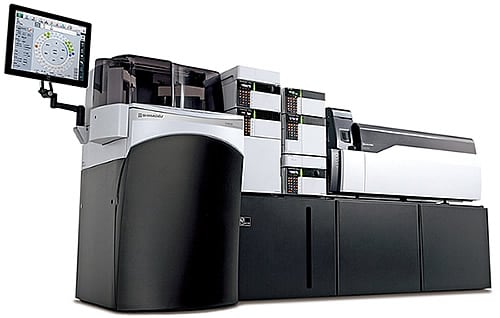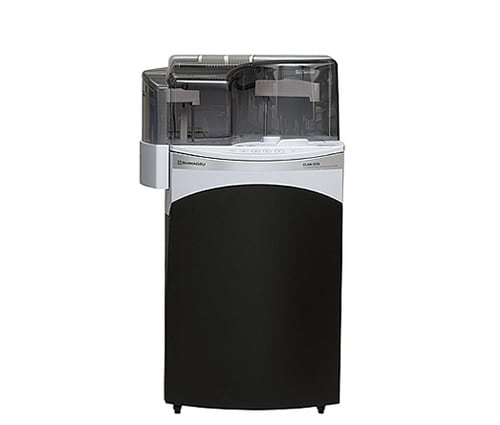January 9, 2019 | News & Notices
Automating the Analysis of Biological Samples to Provide a Revolutionary Workflow
Shimadzu’s New CLAM-2030 Fully Automated Preparation Module for LCMS

CLAM-2030 Fully Automated Sample Preparation Module for LCMS (System with the LCMS-8060)

CLAM-2030 Fully Automated Sample Preparation Module for LCMS (Module Itself)
Shimadzu has released the CLAM-2030 fully automated preparation module for LCMS. This module automates everything from the preparation of urine, blood, and other biological samples to measurement via liquid chromatography mass spectrometry (LCMS). Conventionally, when measuring blood samples with LCMS, it takes 15 to 20 minutes for the preparatory process, which includes the addition of reagents, mixing of the solution, and the addition of a deproteinization liquid. The CLAM-2030 preparation module, in contrast, completes this process in 3 to 8 minutes. Further, if the samples and reagents are placed and positioned in special containers for automatic conveyance to the LCMS by an autosampler, the module can perform all of the processes automatically, on holidays and overnight.
In recent years, at clinical research sites, the monitoring of drug concentrations in blood samples, searches for biomarkers, and metabolic evaluations have become prevalent due to the arrival of LCMS, which is capable of high-sensitivity analysis and high-speed processing. At the same time, because preparation is indispensable for blood sample analysis, and the processing of infectious samples including pathogens is required, issues remain with respect to the time and workload involved in the measurement of large quantities of samples. In 2015, Shimadzu released the SCLAM-2000 fully automated preparation module for LCMS, a precursor to the CLAM-2030, as a means of improving the efficiency of the analysis process. In 2017, this instrument was registered as a class 1 medical device.
In response to the needs at clinical research sites, the CLAM-2030 provides stable data acquisition, lower running costs, and improved work efficiency. The module can be connected to four models of triple quadrupole liquid chromatograph mass spectrometers, the LCMS-8040, LCMS-8045, LCMS-8050, and LCMS-8060. Work efficiency is further improved by using it in combination with a commercial analysis kit.
Shimadzu is involved in the advanced healthcare business, creating revolutionary products and services in the medical field as part of our current medium-term management plan. We will continue to research and develop products and technologies, doing our best for medical personnel and their patients through the widespread adoption of Shimadzu products at clinical sites.
Features
1. Capable of Processing up to 60 Samples
Simply place the special preparation containers in the module to enable the automatic measurement of up to 60 samples. Approximately 20 samples can be processed per hour. If the forensic toxicological database and the rapid toxicology screening system (options available from Shimadzu) are used, the library can be searched automatically and reports can be output after preparation.
2. High Reliability
A special structure (using septa) prevents the vaporization of internal standard substances, which suppresses concentration fluctuations, leading to a more stable measurement process. Additionally, multiple management functions, including ID management of samples via a barcode reader (option), management of the expiration dates and remaining quantities of reagents, and maintenance log records, maintain the module in an optimal state.
3. Reduced Operational Mistakes and Risk of Infections
After samples and reagents are positioned, preparation can be started with simple operations, alleviating mistakes due to manual procedures. The waste box for preparation containers and the waste liquid tank are equipped with full sensors, which help reduce the risk of infections during sample preparation.
| Note | : | This product has not been approved or certified as a medical device under the Japanese Pharmaceutical and Medical Device Act. It cannot be used for therapeutic or diagnostic purposes or their procedures. |
For more details, visit
CLAM-2030


